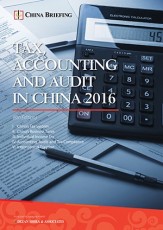China’s New Related Party Transaction Reporting Regulation: Implications for Annual Audit in China
By Dezan Shira & Associates
Editor: Jake Liddle
As the end of the financial year looms, key considerations in respect of annual audit should be made by multinational entities (MNEs) operating in China. On June 29, 2016, China’s State Administration of Taxation (SAT) issued a notice regarding reporting of related party transactions and administration of transfer pricing documentation (SAT public notice [2016] No. 42), hereby referred to as ‘Notice 42’, which was overviewed in our previous article. It updates and provides new transfer pricing requirements and special tax revisions previously provided in Guo Shui Fa [2008] No. 114 and Guo Shui Fa [2009] No.2, sections of which have been replaced or annulled. Notably, it details on annual reporting forms for related party transactions (RPT forms), which this article explores in depth.
New law
The new law stipulates that a report of yearly related party business transactions should be submitted to tax authorities along with yearly enterprise income tax returns by both resident and non-resident enterprises that have established entities or premises in China. In the report, the number of related party filing forms has been increased from nine to 22, including information disclosure of the Country-by-Country (CBC) Report. The new law indicates that the filing report is required to contain the following:
- Comprehensive information of the reporting company, including information regarding basic company details, internal departments, employee headcount, senior management, and shareholders, etc.
- Detailed information of both sides’ financial asset transactions, equity investments, and cost sharing agreements.
- Information of the overseas related party, including registered business address, actual operation address, business scope, applicable tax rate, and any relevant income tax incentives.
- Current financial situation of the reporting company, including inbound and outbound related and non-related party transactions.
- Segmented financial reports based on the individual entity’s financial report along with the consolidated financial report.
Additionally, the CBC Report form needs to be filed in accordance with the information disclosure requirement stipulated by Action 13 of the OECD’s Base Erosion and Profit Shifting (BEPS) Project. CBC Reports are required for the following taxpayers, and must be submitted in both English and Chinese for either:
- Resident taxpaying ultimate shareholding company of the group with consolidation revenue for the previous accounting year exceeding RMB 5.5 billion.
Or
- Enterprises which have been designated as the reporting party of the CBC Report. This requirement is similar to Action 13 of OECD BEPS Actions.
![]() RELATED: Audit and Financial Services from Dezan Shira & Associates
RELATED: Audit and Financial Services from Dezan Shira & Associates
Definition of related party transactions
The new law also expounds on what is considered a related party transaction, laying down a clear outline as follows:
- Transfer of usage rights or ownership of tangible assets, the latter of which includes commodities, products, buildings, vehicles, machinery, and equipment, etc.
- Transfer of financial assets, which include assets deriving from accounts receivable, bills receivable, other receivables, equity investments, debt investments, and derivative financial instruments, etc.
- Transfer of use rights or ownership of intangible assets, which include patents, non-patented technologies, commercial secrets, trademarks, brands, client lists, sales channels, franchise rights, government licensing, copyright, and other such items.
- Financial (fund) intermediation. Such funds include various long-term and short-term borrowed funds (including enterprise group capital pools), guarantee fees, different types of accrued interest advances and deferred payables and receivables etc.
- Service transactions, which include those for market surveys, marketing planning, agencies, design, consultancy, administration, technical services, contract R&D, repair and maintenance, legal services, financial management, audit, recruitment, training, centralized procurement, etc.
Analysis and risk management
The increase of filling forms somewhat increases risks for multinational enterprises. The segmented financial report will provide a comparison of the profitability between related parties and non-related parties, and a substantial disparity between the two will trigger the attention of tax authorities, thus constituting an increase of taxpayers’ risk. Therefore, for entities who have not previously prepared segmented financial reports in the past, it is advisable to base this financial year’s report on 2015 financial data and then revise it if there is a noticeable disparity between profits and sales.
Furthermore, compliance burden for taxpayers will be increased by the tightened requirement for information disclosure of overseas related parties, and as some entities maintain multiple related party relationships, one way to keep abreast of the increased burden is to ensure relevant information is collected in both an accurate and timely fashion.
The related party transaction forms will become instrumental components for tax authorities to select investigation targets via the means of big data analytical systems, which have been implemented by the SAT across the board of tax authorities. This highlights the overall importance of upholding compliance, and implementing effective management of related party transactions.
China’s adherence to the OECD’s tax principles in the form of the BEPS project is a sign that the country is making efforts, along with other member countries, to minimize tax avoidance committed by MNEs by further governing their conduct and operation. New regulation informing related party transaction reporting ultimately serves to ensure that profit allocation aligns with profit formation, and is a sign that China’s tax authorities will commit to more frequent and stringent action to ensure a uniform and effective transfer pricing administration. Thus, companies must be aware of the risks and implications the new regulation brings, especially in its requirement for an increased volume of filing reports, and should adjust management systems as well as take further action to be fully compliant in order to avoid incurring penalties from tax authorities.
|
Asia Briefing Ltd. is a subsidiary of Dezan Shira & Associates. Dezan Shira is a specialist foreign direct investment practice, providing corporate establishment, business advisory, tax advisory and compliance, accounting, payroll, due diligence and financial review services to multinationals investing in China, Hong Kong, India, Vietnam, Singapore and the rest of ASEAN. For further information, please email china@dezshira.com or visit www.dezshira.com. Stay up to date with the latest business and investment trends in Asia by subscribing to our complimentary update service featuring news, commentary and regulatory insight.
|

 Annual Audit and Compliance in China 2016
Annual Audit and Compliance in China 2016
In this issue of China Briefing, we provide a comprehensive analysis of the various annual compliance procedures that foreign invested enterprises in China will have to follow, including wholly-foreign owned enterprises, joint ventures, foreign-invested commercial enterprises, and representative offices. We include a step-by-step guide to these procedures, list out the annual compliance timeline, detail the latest changes to China’s standards, and finally explain why China’s audit should be started as early as possible.
 Tax, Accounting, and Audit in China 2016
Tax, Accounting, and Audit in China 2016
This edition of Tax, Accounting, and Audit in China, updated for 2016, offers a comprehensive overview of the major taxes that foreign investors are likely to encounter when establishing or operating a business in China, as well as other tax-relevant obligations. This concise, detailed, yet pragmatic guide is ideal for CFOs, compliance officers and heads of accounting who must navigate the complex tax and accounting landscape in China in order to effectively manage and strategically plan their China-based operations.
 Establishing & Operating a Business in China 2016
Establishing & Operating a Business in China 2016
Establishing & Operating a Business in China 2016, produced in collaboration with the experts at Dezan Shira & Associates, explores the establishment procedures and related considerations of the Representative Office (RO), and two types of Limited Liability Companies: the Wholly Foreign-owned Enterprise (WFOE) and the Sino-foreign Joint Venture (JV). The guide also includes issues specific to Hong Kong and Singapore holding companies, and details how foreign investors can close a foreign-invested enterprise smoothly in China.
- Previous Article Case Study: Capital Gain Tax Treatment- Part 2: Capital Gain Tax Calculation
- Next Article Obtaining China’s New Unified Foreign Work Permit



























